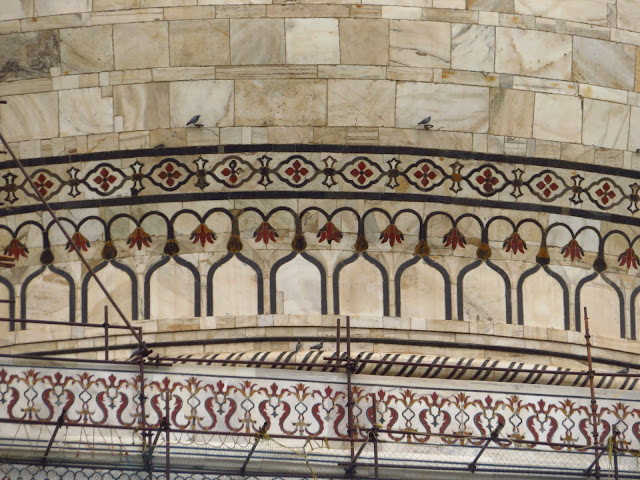visiting the Taj Mahal
Why did I even want to wake up at 5am on a weekend?!? But the day's full of promise; after all, we were visiting one of the world's most famous landmarks: the Taj Mahal! Just to be sure that I had something to eat, I brought some of the choco chip cookies from my hotel room pantry. I shouldn't have worried at all; our driver stopped at a popular rest area to allow us to have a toilet break and to have some substantial breakfast two hours into our trip to Agra (from New Delhi).
I am so thankful for that pit stop because soon after, we were stuck in a very long traffic queue in the expressway. Apparently, there were people on the highway, causing the traffic to slow into a halt. People in cars decided to go down to have a look but I stayed in our car, content with watching the others and the landscape while waiting for the traffic to ease up.
A few hours later, we finally reached Agra, a city by the banks of the Yamuna River in the state of Uttar Pradesh. We were almost at the Taj Mahal!
I had thought that the Taj Mahal was close to the expressway. However, to get to the landmark, we still had to drive along an inner road until our car had to park at the ticket office. From there, we decided to walk with our tour guide to the Taj Mahal.
Just one problem, however. The clouds overhead were threatening to dump rain on us and we didn't have enough umbrellas with us! Only Jhoanne brought hers. Mine was in the hotel. And because of the heat, nobody thought of carrying jackets.
As we entered the Taj Mahal compound, the thunderstorm started in earnest; the mausoleum was masked by the haze and lightning kept zipping through the sky seemingly near the Taj Mahal. I was thinking that it might not be such a good idea to be out in the open in that thunderstorm. Good thing that there was a gate under which we could take shelter from the storm. We waited it out with other tourists who actually got drenched by the rain.
The change in the appearance of the Taj Mahal, thanks to the mist lifting, was nothing short of dramatic. The colour of the marble really stood out of the grey clouds after the rain! We could clearly see that parts of the Taj Mahal was under some sort of repair, perhaps cleaning... and I remembered a text I read about how the Indian government was taking efforts to protect the building from pollution.
Rightly so because the Taj Mahal is one of the country's cultural heritage from the Mughal period (being completed in 1643). And it's the grandest expression of love: the king Shah Jahan had the mausoleum built for his wife, Mumtaz Mahal. Her tomb is found in the middle of the building, surrounded by the most precious of marbles inlaid with precious and semi-precious gemstones. The calligraphy on the mausoleum's exteriors is a beautiful example of forced perspective: the characters were bigger at the top so that they would look like they were the same size as the characters closer to the base of the building.
Aside from the mausoleum, Shah Jahan had a mosque and a guesthouse built on either side of Taj Mahal. Our guide said that this was to maintain symmetry, an important element in Mughal architecture. Visually, these two buildings were distinct because the builders used red stones rather than white marble.
As our tour in and around the Taj Mahal complex drew to a close, I couldn't help but notice other parts of the complex, struggling to be noticed... but how could they compete with the majesty of the Taj Mahal, right? Sadly, many of the structures appear to be slowly swallowed by the jungle; a testament to man's constant struggle to tame nature and how nature normally wins, provided that enough time has passed.
Our tour guide (I forgot his name), showed us other interesting features of the Taj Mahal and gave us a few insights on how important this place is for preserving Mughal heritage. For instance, I am fascinated by the idea that the present-day descendants of the original stoneworkers are still involved in the care of the mausoleum complex. He also showed us interesting details about the gemstones inside the mausoleum. At one point, I got blessed (according to our guide) by one who appeared to be an imam; this guy also caught us by surprise by bellowing inside the mausoleum... something about demonstrating an acoustic character of the building.
A few hours after we started running for shelter, we finished our tour and we were back to where we started learning about the love story between Shah Jahan and Mumtaz Mahal. We were quite wet and disheveled but we definitely had fun and we learned a lot of new things.
What a culture vulture weekend, indeed!














Comments
Post a Comment
Thank you for dropping by!
Before moving on, please share your thoughts or comments about the post. :)
Thanks again!